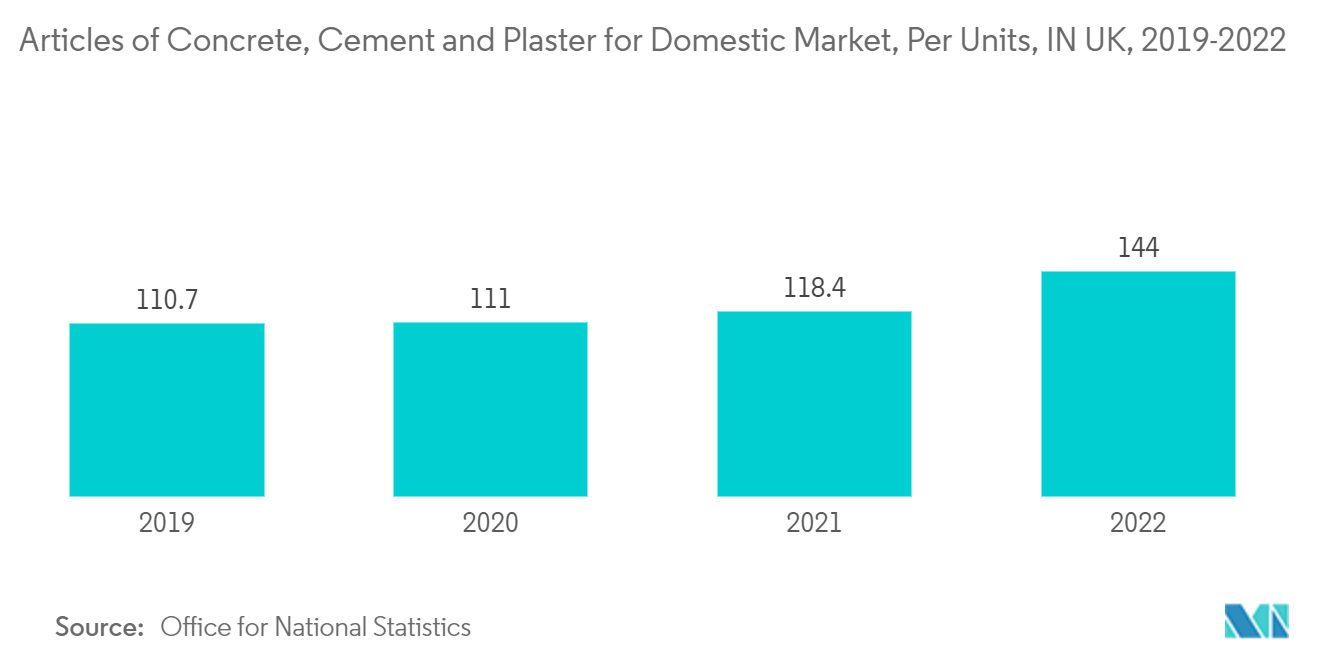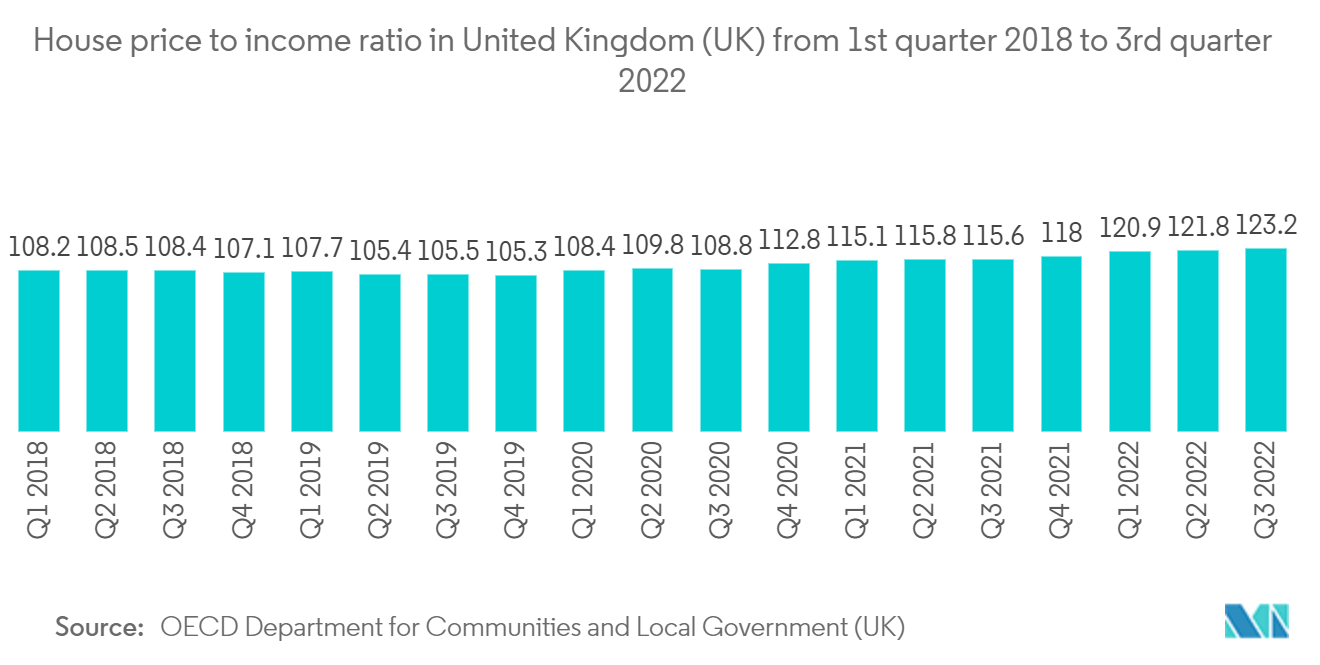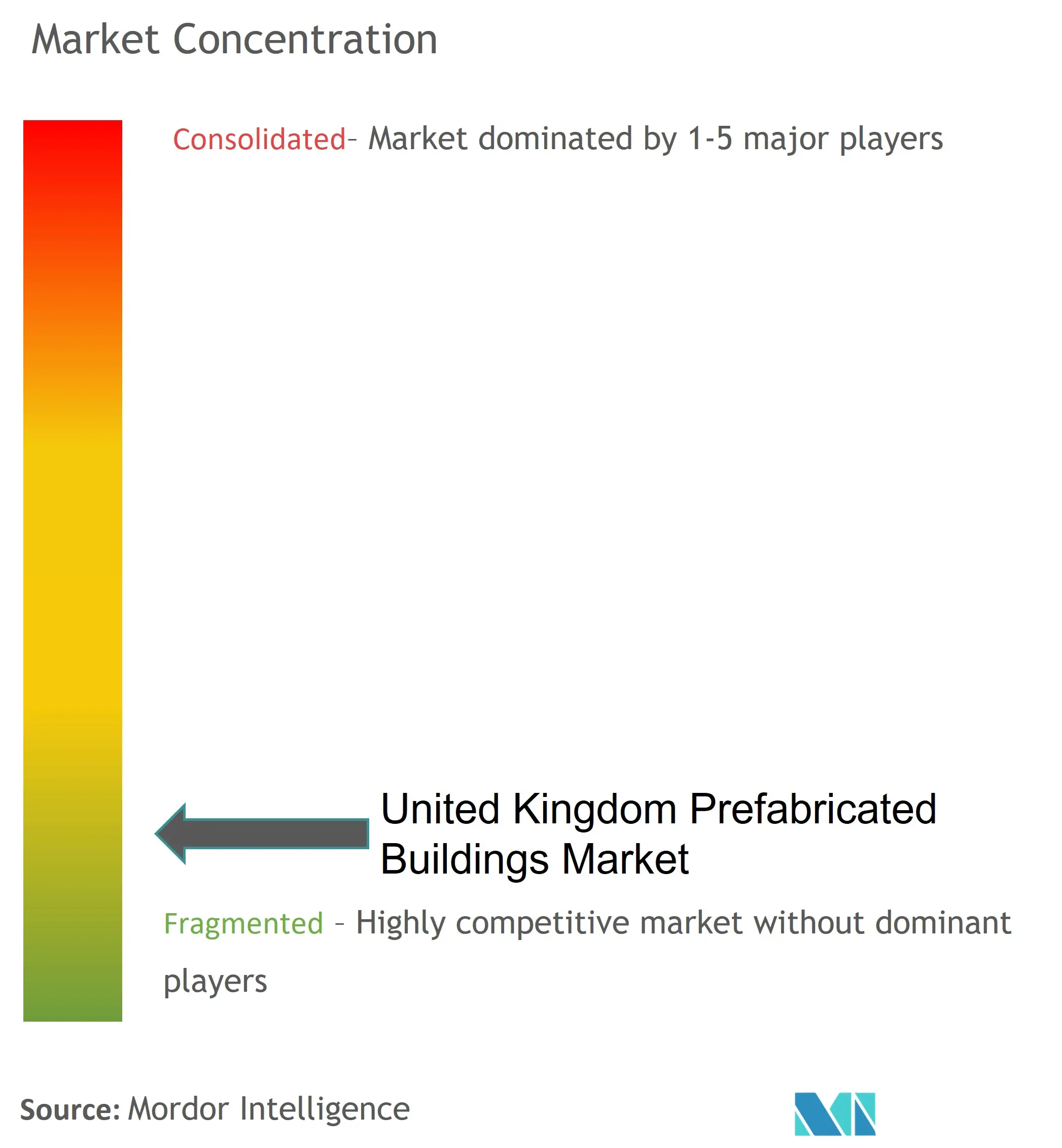UK Prefabricated Buildings Market Size

| Study Period | 2019 - 2029 |
| Base Year For Estimation | 2023 |
| Market Size (2024) | USD 7.38 Billion |
| Market Size (2029) | USD 9.96 Billion |
| CAGR (2024 - 2029) | 6.17 % |
| Market Concentration | Low |
Major Players_-_Copy.webp)
*Disclaimer: Major Players sorted in no particular order |
UK Prefabricated Buildings Market Analysis
The United Kingdom Prefabricated Buildings Industry is expected to grow from USD 7.38 billion in 2024 to USD 9.96 billion by 2029, at a CAGR of 6.17% during the forecast period (2024-2029).
The ease of construction, affordability, and fast delivery drive the market. Furthermore, the market is driven by the huge investments coming into the market.
Modular construction is becoming more and more popular in the European region as a result of population growth and housing shortage. Modular construction is becoming increasingly popular as an affordable housing option. More and more modular homes are being built in the UK. The leading construction companies, investors, and the leading developers in the UK are looking for the best prefabrication solutions. The growing investment in the UK modular construction sector is also contributing to the development of the UK prefab industry.
Modular housing is relatively new in the UK compared to countries like Japan and Germany, where it’s more established, and it’s still essentially a loss-making industry. But the good news is that faster construction of high-quality homes could be part of the solution to the UK’s long-term housing problem.
According to estimates from Make UK Modular, the industry will have the capacity to construct 20,000 new modular homes in 2025, which would be one-fifth of the annual shortfall of 100,000 homes. The government has set itself a target of creating 300,00 new homes per year by 2025, with official figures showing that 204,500 new homes were constructed in the 12 months to March 2022.
UK Prefabricated Buildings Market Trends
Need for Precast Concrete Technology Driving the Market
There is a growing demand for precast concrete in the construction industry (residential and commercial) in the UK. Structural building components are in high demand due to various factors such as fast installation, variety of options, ease of maintenance, and low cost.
The growing demand for sustainable and environmentally friendly building products is driving the structural building component segment of the precast concrete market in the UK. The growing awareness of cost-effective and easy-to-maintain building materials is driving the market for structural building components within the precast concrete industry in the UK. Precast concrete structural building components help to reduce installation, repair, and maintenance time. This is one of the key factors driving the UK market for precast concrete structural components.

Opportunities in Affordable Housing & Residential Construction to Boost the Prefab market in 2023 and Going Forward
While technology has revolutionized many aspects of life, including transportation, entertainment, shopping, and consumer goods, housebuilding has been slow to catch up. That is all set to change with the introduction of the next generation of factory-built modular homes.
A new report from Make UK Modular, in collaboration with KOPE, has revealed that by 2025, the modular housing industry will be able to provide 20,000 energy-efficient, low-carbon homes across the UK. These homes will be 55% less likely to need to be heated than the average UK family house and will be built twice as fast.
Modular manufacturers are already setting up plants in post-industrial small towns or cities, employing more than 3,000 people, and bringing GBP 700 million (USD 860.10 million) of investment to low-growth, low-employment areas.
The government has expedited the planning process for modular homes and committed to 20% of the affordable housing program for modular homes, which would double new jobs in a short period.

UK Prefabricated Buildings Industry Overview
The United Kingdom Prefabricated Buildings Market is fragmented and highly competitive, with a few players occupying the major share. The major players include Barratt Developments PLC, Bellway Homes Limited, Berkley Group, Weberhaus, and many more. There is an increase in prefab construction building investments and upcoming major projects in the country, and other factors are driving the market. Berkley Homes, one of the largest players, also announced plans to open a factory in Kent to produce a thousand homes a year. Recently, Goldman Sachs invested USD 93 million in TopHat, a leading player in the prefab industry in the UK.
UK Prefabricated Buildings Market Leaders
-
Barratt Developments P L C
-
Bellway Homes Limited
-
Berkley Group
-
Weberhaus
-
BALFOUR BEATTY GROUP LIMITED
*Disclaimer: Major Players sorted in no particular order

UK Prefabricated Buildings Market News
- August 2023: UK offsite company Premier Modular has received new investment from London-headquartered private equity firm MML Capital Partners.
- December 2022: Modulaire Group, a European specialist provider of modular services and infrastructure, announced the acquisition of Mobile Mini UK, a provider of storage containers and site accommodations. WillScot Mobile Mini Holdings Corp's subsidiary has 16 locations across the UK and supplies steel storage and accommodation units to a variety of industries, including construction, retail, manufacturing, healthcare, and education.
UK Prefabricated Buildings Market Report - Table of Contents
1. INTRODUCTION
- 1.1 Study Assumptions and Market Definitions
- 1.2 Scope of the Study
2. RESEARCH METHODOLOGY
- 2.1 Analysis Methodology
- 2.2 Research Phases
3. EXECUTIVE SUMMARY
4. MARKET INSIGHTS
- 4.1 Current Market Scenario
- 4.2 Technological Trends
- 4.3 Insights on Supply Chain/Value Chain Analysis of the Prefabricated Buildings Industry
- 4.4 Brief on Different Structures Used in the Prefabricated Buildings Industry
- 4.5 Cost Structure Analysis of the Prefabricated Buildings Industry
- 4.6 Impact of COVID 19
5. MARKET DYNAMICS
-
5.1 Drivers
- 5.1.1 Growing Infrastructure Investments
- 5.1.2 Government Initiatives in the Infrastructure and Construction Sector to Boost the Industry
-
5.2 Restraints
- 5.2.1 Limited Adaptability during Construction
-
5.3 Opportunitites
- 5.3.1 Speedy Green Building Construction
-
5.4 Porter's Five Forces Analysis
- 5.4.1 Bargaining Power of Suppliers
- 5.4.2 Bargaining Power of Consumers / Buyers
- 5.4.3 Threat of New Entrants
- 5.4.4 Threat of Substitute Products
- 5.4.5 Intensity of Competitive Rivalry
6. MARKET SEGMENTATION
-
6.1 Material Type
- 6.1.1 Concrete
- 6.1.2 Glass
- 6.1.3 Metal
- 6.1.4 Timber
- 6.1.5 Other Material Types
-
6.2 Application
- 6.2.1 Residential
- 6.2.2 Commercial
- 6.2.3 Other Applications ( Industrial, Institutional, and Infrastructure)
7. COMPETITIVE LANDSCAPE
- 7.1 Overview (Market Concentration and Major Players)
-
7.2 Company Profiles
- 7.2.1 Barratt Developments PLC
- 7.2.2 Persimmon Homes Limited
- 7.2.3 Bellway Homes Limited
- 7.2.4 Berkley Group
- 7.2.5 Balfour Beatty Group Limited
- 7.2.6 Morgan Sindall Group PLC
- 7.2.7 Galliford Try Limited
- 7.2.8 Kiss House
- 7.2.9 Facit Homes
- 7.2.10 Redrow
- 7.2.11 Phoenix Homes
- 7.2.12 Webrhaus*
- *List Not Exhaustive
8. MARKET OPPORTUNITIES AND FUTURE TRENDS
9. APPENDIX
- 9.1 Marcroeconomic Indicators (GDP breakdown by sector, Contribution of construction to economy, etc.)
- 9.2 Key Production, Consumption,Exports & import statistics of construction Materials
UK Prefabricated Buildings Industry Segmentation
Prefabricated buildings, also known as prefabs, are structures made up of components (walls, roof, and floor) that are produced in a factory or manufacturing plant. These components can be completely or partially assembled in a factory before being transported to the job site. This method of building construction is preferred because of its low cost, quick turnaround, and reusability. Prefabricated buildings are commonly used for temporary construction facilities, office spaces, medical camps, evacuation centers, schools, apartment buildings, and single-family homes.
A complete background analysis of the United Kingdom Prefabricated Buildings Market, including the assessment of the economy and contribution of sectors in the economy, market overview, market size estimation for key segments, and emerging trends in the market segments, market dynamics, and geographical trends, and COVID-19 impact is included in the report.
The United Kingdom's prefabricated buildings market is segmented by material type (concrete, glass, metal, timber, and other material types) and by application (residential, commercial, and other applications (infrastructure and industrial)). The report offers market size and forecast values (USD) for all the above segments.
| Material Type | Concrete |
| Glass | |
| Metal | |
| Timber | |
| Other Material Types | |
| Application | Residential |
| Commercial | |
| Other Applications ( Industrial, Institutional, and Infrastructure) |
UK Prefabricated Buildings Market Research FAQs
How big is the United Kingdom Prefabricated Buildings Industry?
The United Kingdom Prefabricated Buildings Industry size is expected to reach USD 7.38 billion in 2024 and grow at a CAGR of 6.17% to reach USD 9.96 billion by 2029.
What is the current United Kingdom Prefabricated Buildings Industry size?
In 2024, the United Kingdom Prefabricated Buildings Industry size is expected to reach USD 7.38 billion.
Who are the key players in United Kingdom Prefabricated Buildings Industry?
Barratt Developments P L C, Bellway Homes Limited, Berkley Group, Weberhaus and BALFOUR BEATTY GROUP LIMITED are the major companies operating in the United Kingdom Prefabricated Buildings Industry.
What years does this United Kingdom Prefabricated Buildings Industry cover, and what was the market size in 2023?
In 2023, the United Kingdom Prefabricated Buildings Industry size was estimated at USD 6.95 billion. The report covers the United Kingdom Prefabricated Buildings Industry historical market size for years: 2019, 2020, 2021, 2022 and 2023. The report also forecasts the United Kingdom Prefabricated Buildings Industry size for years: 2024, 2025, 2026, 2027, 2028 and 2029.
What are the emerging trends in the UK Prefabricated Building Market?
The emerging trends in the UK Prefabricated Building Market are a) Use of digital technologies like Building Information Modeling (BIM) for design and construction optimization b) Integration of prefabricated elements with traditional construction methods for hybrid approaches c) Increased focus on prefabricated buildings for sustainable and green construction projects
UK Prefabricated Buildings Industry Report
The UK's prefabricated building market, including prefabricated houses in the UK, has undergone significant evolution from its early 20th-century origins, driven by the need for rapid wartime construction, to a modern industry marked by technological advancements and sustainability focus. This market resurgence is fueled by efficiency, cost-effectiveness, and environmental benefits. Modular construction, a popular prefabrication technology, meets the urgent demand for various building types while ensuring quality and minimizing waste. The market is segmented by materials like steel, concrete, wood, light gauge steel framing systems, and cross-laminated timber, each catering to specific construction needs. Prefabricated buildings are utilized across residential, commercial, and industrial sectors, from quick-assembly homes to robust industrial facilities. The growth of this market is propelled by a cultural shift towards sustainable practices and the acceptance of prefabricated structures' aesthetic and practical potential. Despite challenges like quality misconceptions and complex regulations, the industry's future is promising as it continues to innovate and expand, especially in prefabricated houses in the UK. For detailed statistics, market share, size, and revenue growth insights, refer to Mordor Intelligence™ Industry Reports, which include market forecasts and historical overviews, available as free report PDF downloads.



